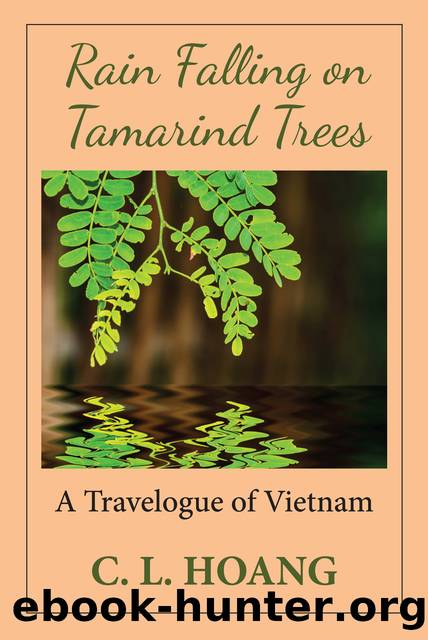Rain Falling on Tamarind Trees by C. L. Hoang

Author:C. L. Hoang
Language: eng
Format: epub
Publisher: C. L. Hoang
Thiên-Mụ Pagoda over the Perfume River.
Flanking the tower, whose seven stories symbolize the seven stages of enlightenment in Buddhism, are two hexagonal pavilions. One of them shelters an eight-foot stone stele riding on the back of a marble tortoise (ca. 1715), and the other a huge bronze bell called Äại Há»ng Chung, eight feet tall and weighing over three tons. The bell was cast in 1710, and its toll can be heard for miles around. Beyond, colorful and larger-than-life sculptures of fearsome deities stand guard at a three-way entrance that leads into a beautiful courtyard; the main temple, Äại-Hùng (Great Hero) Shrine; other worship halls; and facilities for residing bonzes. The sweeping view of mountains and river from this hilltop is breathtaking, almost otherworldly. It complements to perfection the noble architecture and the long, rich history to make Thiên-Mụ Pagoda the defining landmark of Huế, immortalized in literature, music, and folk rhymes (ca dao).
Back at the bottom of the hill, we are picked up by the bus, which then crosses back over the river to the south bank. After a 20-minute drive through sparsely populated areas, it deposits us at the entrance to the mausoleum of Emperor Tá»±-Äức. Although 13 rulers sat on the imperial throne between 1802 and 1945, only seven were buried in their own mausoleums (or lÇng) around the capital. Of those seven Royal Tombs, which together with the Old Citadel form Huếâs greatest attraction, this one, dedicated to the fourth emperor, is the largest and considered by many the most exquisitely designed. Built in a valley within a pine forest, it initially served as the emperorâs favorite retreat during the remainder of his lifetime. The walled enclosure, set amidst fragrant pines and frangipani trees and dotted with tranquil ponds, includes no less than 50 structures of various sizes. Their names all contain the term âKhiêmâ (Humility) to express the emperorâs belated remorse for having burdened his people with such a grandiose construction project. The mausoleum itself has come to be known as Khiêm LÇng.
Past the main entrance at Vụ-Khiêm Gate, we amble along the shore of a lake-stream where a pair of pavilions rises out of the water like lotus flowers. I instantly recognize this beloved vista of Khiêm LÇng, which captures so well the natural beauty and serenity itâs famous for. Directly above the lake, we scale two flights of stone steps and arrive at Khiêm-Cung Môn, the majestic three-way, double-story entry gate to the walled compound of palaces and temples. The emperor and his entourage of concubines and mandarins used to stay here when they came out from the Citadel, so the compound also includes work offices and a royal theater, one of the oldest in the country. After his death in 1883 at the age of 54, most of these buildings were converted into funerary halls to house the altars of the emperor, his wives, and the Queen Mother Từ-Dụ.
Next to the palatial compound, and sloping uphill, is the tomb area proper. Passing
Download
This site does not store any files on its server. We only index and link to content provided by other sites. Please contact the content providers to delete copyright contents if any and email us, we'll remove relevant links or contents immediately.
China Rich Girlfriend by Kwan Kevin(3899)
The Silk Roads by Peter Frankopan(3764)
Annapurna by Maurice Herzog(2844)
Hot Thai Kitchen by Pailin Chongchitnant(2814)
Full Circle by Michael Palin(2778)
Okonomiyaki: Japanese Comfort Food by Saito Yoshio(2391)
City of Djinns: a year in Delhi by William Dalrymple(2138)
The Ogre by Doug Scott(2116)
Photographic Guide to the Birds of Indonesia by Strange Morten;(2090)
Tokyo by Rob Goss(2020)
Vietnam, Cambodia, Laos & Northern Thailand by Lonely Planet(2015)
Tokyo Geek's Guide: Manga, Anime, Gaming, Cosplay, Toys, Idols & More - The Ultimate Guide to Japan's Otaku Culture by Simone Gianni(1949)
Discover China Travel Guide by Lonely Planet(1867)
Everest the Cruel Way by Joe Tasker(1828)
China (Lonely Planet, 11th Edition)(1799)
Lonely Planet China(1758)
China Travel Guide by Lonely Planet(1741)
Top 10 Dubai and Abu Dhabi by DK Travel(1718)
Iranian Rappers And Persian Porn by Maslin Jamie(1711)
